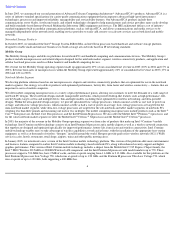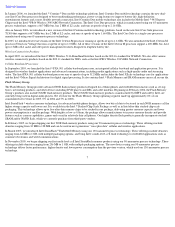Intel 2005 Annual Report Download - page 17
Download and view the complete annual report
Please find page 17 of the 2005 Intel annual report below. You can navigate through the pages in the report by either clicking on the pages listed below, or by using the keyword search tool below to find specific information within the annual report.
Table of Contents
We plan to continue to cultivate new businesses and work with the computing and communications industries through standards bodies, trade
associations, OEMs, ODMs, and independent software and operating system vendors to align the industry to offer products that take advantage of the
latest market trends and usage models. These efforts include helping to create the infrastructure for wireless network connectivity. We are also
working with these industries to develop software applications and operating systems that take advantage of our platforms. We frequently participate
in industry initiatives designed to discuss and agree upon technical specifications and other aspects of technologies that could be adopted as standards
by standards-setting organizations. In addition, we work collaboratively with other companies to protect digital content and the consumer by
developing content protection specifications such as the Digital Transmission Content Protection (DTCP) specification. DTCP defines a secure
protocol for protecting audio and video entertainment content from illegal copying, intercepting and tampering as it moves across digital interfaces
such as Universal Serial Bus (USB) and IP-based home networks. Our competitors may also participate in the same initiatives and specification
development, and our participation does not ensure that any standards or specifications adopted by these organizations will be consistent with our
product planning. We continuously evaluate all of our product offerings and the timing of their introduction, taking into account factors such as
customer requirements and availability of infrastructure to take advantage of product performance and maturity of applications software for each type
of product in the relevant market segments.
Companies in the semiconductor industry often rely on the ability to license patents from each other in order to compete in today’s markets. Many of
our competitors have broad cross-
licenses or licenses with us, and under current case law, some such licenses may permit these competitors to pass our
patent rights on to others. If one of these licensees becomes a foundry, our competitors might be able to avoid our patent rights in manufacturing
competing products. In addition to licensing our patents to competitors, we participate in some industry organizations that are engaged in the
development of standards or specifications and may require us to license our patents to other companies that adopt such industry standards or
specifications, even when such organizations do not adopt the standards or specifications proposed by Intel. Any Intel patents implicated by our
participation in such initiatives might not, in some situations, be available for us to enforce against others who might be infringing those patents.
We continue to be largely dependent on the success of our microprocessor business. Many of our competitors, including Advanced Micro Devices,
Inc. (AMD), our primary microprocessor competitor, market software-compatible products that compete with Intel architecture-based processors. We
also face competition from companies offering rival microprocessor designs, such as International Business Machines Corporation (IBM), which is
jointly developing a rival architecture design with Sony Corporation and Toshiba Corporation. Our desktop processors compete with products offered
by AMD, IBM and VIA, among others. Our mobile microprocessor products compete with products offered by AMD, IBM, Transmeta Corporation
and VIA, among others. Our server processors compete with software-compatible products offered by AMD and with products based on rival
architectures, including those offered by IBM and Sun Microsystems, Inc.
Our chipsets compete in the various market segments against different types of chipsets that support either our microprocessor products or rival
microprocessor products. Competing chipsets are produced by companies such as ATI Technologies, Inc., Broadcom, NVIDIA, Silicon Integrated
Systems Corporation (SIS) and VIA. We also compete with companies offering graphics components and other special-purpose products used in the
desktop, mobile and server market segments. One aspect of our business model is to incorporate improved performance and advanced properties into
our microprocessors and chipsets, the demand for which may increasingly be affected by competition from companies, such as ATI and NVIDIA,
whose business models are based on incorporating performance into dedicated chipsets and other components, such as graphics controllers.
Our NOR flash memory products currently compete with the products of other companies, such as Samsung Electronics Co., Ltd., Spansion Inc., and
STMicroelectronics NV. The megabit demand of the products that make use of flash memory is increasing, and our NOR flash memory products face
increased competition from companies that manufacture NAND flash memory products, as OEMs look for opportunities to use NAND flash memory
products with additional random access memory or in combination with NOR flash memory for executable-code applications. In January 2006, we
formed IMFT, a NAND flash memory manufacturing company, with Micron that may provide us with more competitive opportunities with regard to
NAND flash memory products. See
“Note 16: Venture” in Part II, Item 8 of this Form 10-K.
We also offer products designed for wired and wireless connectivity; for the communications infrastructure, including network processors; and for
networked storage. These products currently compete against offerings from companies such as Applied Micro Circuits Corporation, AMD,
Broadcom, Freescale Semiconductor, Inc., IBM, Marvell Technology Group Ltd., NMS Communications Corporation, OpNext, Inc. and Sun
Microsystems.
13
























